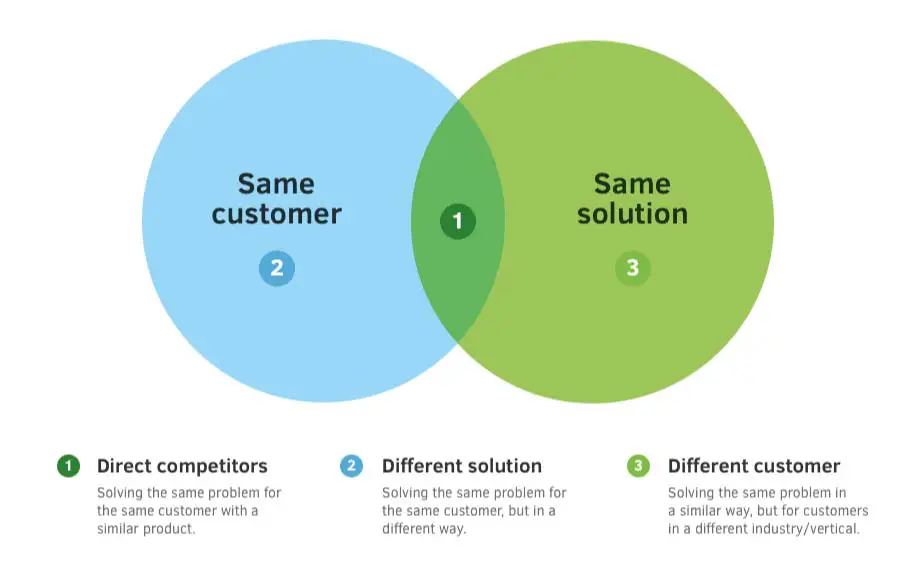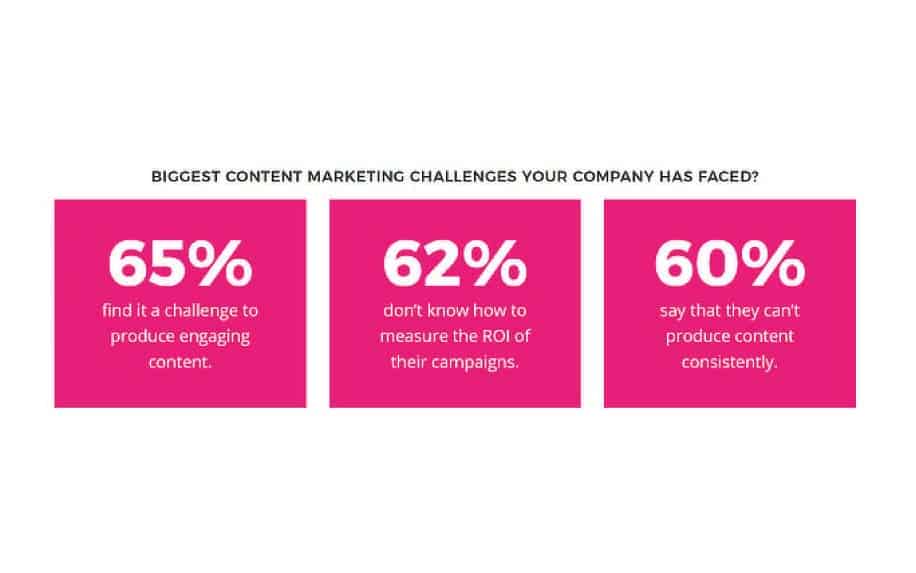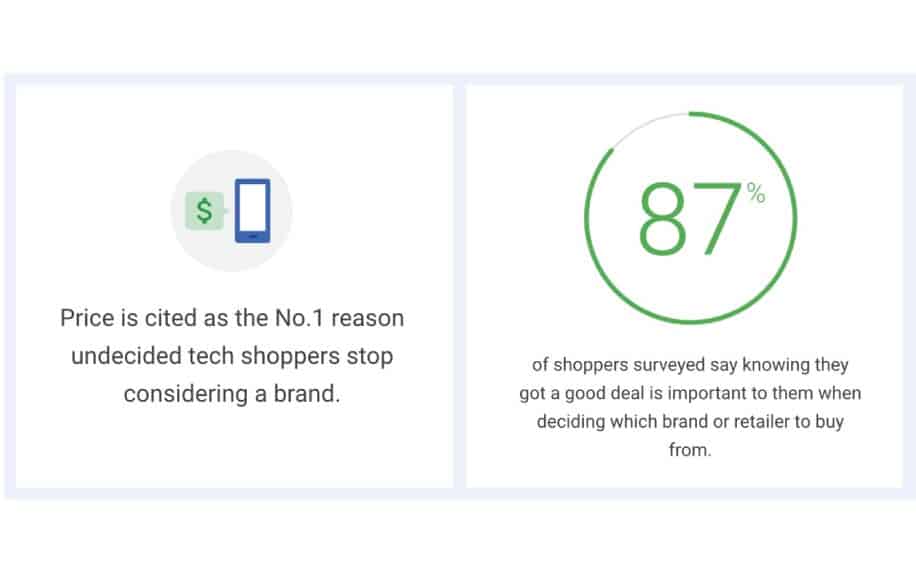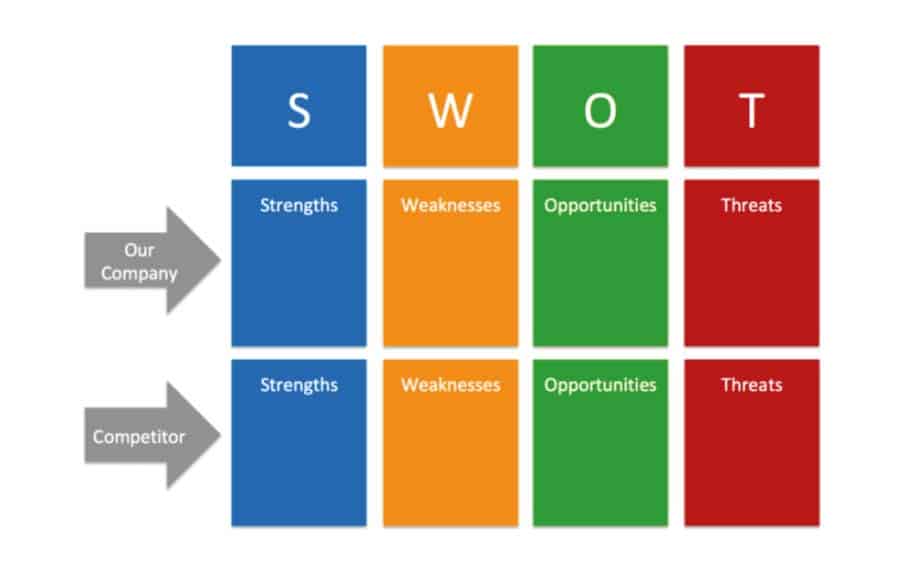What is competitive analysis? In the context of digital marketing, this mainly means figuring out what works for your competitors, and mimicking it. These might be ideas for your own strategy, or different types of customers to target.
While you should stay in line with the marketing strategies outlined in your business plan, it’s important to keep an eye out for new ideas.
That’s why you should monitor your competition and their activities on an ongoing basis.
By learning what your competitors are doing, their perception of the market, and the marketing tactics they use, you’ll acquire a competitive advantage. This is the goal of competitive analysis.
Let’s start with the basics.

Table of Contents
What is Competitive Analysis?
Competitive analysis in marketing is assessing the competitive environment in which your business operates. That way, you can establish the strengths & weaknesses of your business plus those of your competitors.
It also includes learning the demographics and the desires of potential customers, and the strategies you can use to improve your position in the marketplace.
Here are some of the concrete benefits of competitive analysis for your business.
Competitive Analysis: Benefits to Your Business
Almost every marketer conducts some kind of competitive analysis. However, they’re not always particularly effective at doing so. This is typically because they don’t have a systematic way of analysing their competitors.
Ignoring competitive analysis in marketing means ignoring key industry trends. Therefore, there’s a direct correlation between competitive analysis and higher conversion growth.
The chances are that if you’re conducting competitive analysis but not seeing results, you’re doing something wrong.
Here are some of the benefits you can expect to see from competitive analysis.
- Helps you to avoid being complacent and become more adaptive, innovative and improve so you can compete effectively,
- Enables you to determine your strengths and weaknesses,
- A significant competitive analysis benefit is that it helps you how to capitalize on your competitors’ strengths and take advantage of their weaknesses,
- Makes it possible to identify and adopt new market trends,
- Acts as a motivating factor for improving your digital catalog.

How to Conduct a Competitive Analysis for Digital Marketing
Businesses use different competitive analysis models to learn about other businesses. Provided you understand the key objectives, the approach or competitive analysis models you employ aren’t particularly important.
Here are the five core steps for any competitive analysis process.
1. Identify and Create a List of Your Top Competitors
Who are your chief competitors in your specific business? It doesn’t matter what industry you operate in. Every organisation has competitors of some kind.
No matter what kind of business you run, there is always someone who wants to reach the same audience as you. Once your list is complete, go ahead and highlight the companies that present the greatest challenge to your market share.
Since most of the companies can be found online, it’s pretty simple to identify your competitors. So, to find out who your key business competitors are:
- Conduct a Google search of your product or service and the top companies will appear,
- Semrush is also another tool you can use to find your top competitors,
- Ask your customers to tell you what other business they would consider for the same product or service,
- Attend the latest industry conferences and check a list of the presenters or companies running booths,
You’ve got a comprehensive list of your top competitors now. The next thing is to rank them into categories depending on the type of competition they pose. In that case, you’ll end up with three categories: primary competition, secondary competition, and tertiary competition.
Primary Competitor Analysis
Businesses targeting the same audience or offering similar products, or both. In other words, these are other companies which offer the same kinds of products and services as your own. Pay special attention to pricing and features.
Secondary Competition
Competitors offering either a high or low-end version of your product. Or maybe selling something similar to a diverse audience. These are people who solve the same core problems, but with different kinds of products and services.
Tertiary Competition
Businesses related to yours and will come in handy when you want to expand your product catalog. These are businesses which target similar customers to your own, but don’t offer overlapping products.
2. Examine Your Competitors’ Marketing Plans
After identifying and categorizing your business competitors, it’s time to check the strategies they use in marketing their products and services. Snooping at their ads on their sites and other promotional platforms will help a great deal.
Look at your competitions’ sales approaches and their target markets. What do you learn by exploring your competitors’ marketing plan?
You’ll learn;
- How they allocate their budgets on running adverts and other promotional efforts,
- The audience on which your competitors focus their marketing efforts,
- The platforms they use to reach their target customers,
- Updates/trends on the products and pricing,
- New and better product/service distribution channels,
- Branding positioning.
So, how do you go examining your competitors’ marketing plans? Here are a few things to keep an eye on with regards to competitive analysis for digital marketing.
Business Website
Start by checking their website. What’s the first impression you get when you look at the website? How is the website design? How attractive is it and is it optimized for mobile?
Check how they post and do their content marketing. Make sure you don’t forget to look at the customers’ reviews on the website, testimonials and other interactive tools they use to enhance their customers’ experience.

Social Media
Social media presence is increasingly becoming an integral tool for companies to interact with their users and fans. Look at your competitors’ social media channels such as Facebook, Twitter, and Instagram.
Pull a few of their posts & photos and take a look at the comments to know who follows them. How do they engage their followers? Determine how your rivals are using social media and the way they integrate it into their product/service marketing strategies.
This is especially important if they already have a larger audience than yours. This means you can analyse the kinds of posts which get the most engagement, and carry these lessons into your own social media strategy.
SEO Structure and Strategies
A quick analysis of your competitors’ content reveals that they’re offering the same type of content as your business, they frequently update it just as you do and it’s high quality. But then, what is it that they do differently to attract all those customers?
The chances are high your larger competitors’ Search Engine Optimization structure is pretty on point.
Now check how your business rivals are incorporating keywords into the content. What keywords do they use? Successful businesses know how to integrate keywords into the content, title, internal links, image alt tags, etc.
Rather than limit yourself to high-search volumes, target the long-tail keywords that have a low search volume, low competition, but very powerful.
Even if you don’t mimic your competitors’ SEO strategies, competitive analysis is the easiest way to figure out which search terms you should be targeting.
3. Competitor Profiling
If you want to learn what exactly makes your competitors stand out, then you’ve got to dig a little deeper, a process we’ll call competitor profiling.
That implies you should create a profile of your rivals’ business, detailing information regarding the background, competitive advantages, employees, pricing strategies, their financial abilities and of course, their strengths & weaknesses.
Product Pricing
You understand the competitors marketing strategies. Competitive analysis requires that you learn the pricing strategy of other businesses. Pricing is a crucial determinant of the business success irrespective of the industry.
Monitor the pricing strategies of your competitors to determine the position of your pricing if you need to make some improvements. The secret to mastering the pricing game is learning to achieve a price balance for the sake of both the business and the market.
You’ll drive away your current and potential customers to the competition if you set the price of your products or services too high. In the same vein, your business would lose the necessary revenue if you fix the price too low.
While at it, make sure the value of product or service you offer justifies your pricing.

Competitive Advantage
Establish what makes your competitor stand out in the crowd. What are those aspects that help the business perform better than you and the others on the list? Could there be things they offer that you don’t?
What products or services do customers prefer buying from your rival? Providing high-quality products or offering better services are the top ways businesses use to compete effectively.
4. Outline the Strengths and Weaknesses of Each Competitor
By now, you’ve conducted ample research on your competition. The strengths and weaknesses will act as an analysis or summary of the hours of research. Create a worksheet and list the strengths as well as weaknesses of your competitors’ business.
A quality, competitive analysis example features a list of the companies’ weaknesses and strengths under the five core areas of:
- Product,
- Promotion,
- Pricing,
- Distribution,
- And advertising.
Look at those strengths and determine your ability to meet or exceed them.
Similarly, the competitor’s weaknesses should present an opportunity not only to learn but also exploit them, and gain a competitive edge.

5. Watching Out for New Competitors & the Market Outlook
Take a quick look at the current and future market for your product. If the market for your product or service is on an upward trajectory, then it’s possible there are still more customers to reach.
You should expect to face stiff competition if the market for your product is leveling down. And if the product market is splitting into niches, you might want to rethink whatever product you have on offer.
While focusing on your current competition, don’t forget to watch out for new rivals especially if you’re in a relatively easy industry to break into. Make sure you close all the loopholes your competitors might exploit.
Additionally, think about how your industry could be disrupted by new players or emerging technologies. Think about the rise of new players like Tesla in the automotive industry, and all of the legacy brands which failed to see this coming.
Think about how new market segments could emerge, so you can avoid losing out to early adopters and new players.
Competitive Analysis Process and Workflow: Step-by-Step Guide
1. Define Your Goals and Focus:
- What are you trying to achieve with the analysis? (Increase market share, improve product features, refine marketing strategy)
- Which aspects of competition will you analyze? (Products, pricing, marketing channels, customer service)
2. Identify Your Competitors:
- Direct competitors: Companies offering similar products/services to your target audience.
- Indirect competitors: Companies addressing the same needs but with different solutions.
- Use research tools, industry reports, competitor websites, and customer reviews to discover key players.
3. Gather Data:
- Analyze competitor websites: Review product offerings, pricing, messaging, and visuals.
- Research marketing channels: Identify social media presence, SEO strategies, advertising campaigns.
- Monitor customer reviews and feedback: Understand their pain points, preferences, and satisfaction levels.
- Utilize competitor analysis tools like Semrush, SpyFu, or Similarweb for in-depth data collection.
4. Analyze and Benchmark:
- Develop a comparison matrix: Organize key competitor information like features, pricing, brand positioning, and strengths/weaknesses.
- Perform SWOT analysis: Identify each competitor’s Strengths, Weaknesses, Opportunities, and Threats.
- Benchmark your performance: Compare your data (e.g., market share, website traffic, engagement) to competitor benchmarks.
- Use data visualization tools to create charts, graphs, and infographics for clear representation.
5. Identify Insights and Actionable Steps:
- Discover gaps in the market: Are there unmet needs your competitors aren’t addressing?
- Determine your competitive advantage: What sets you apart from the competition?
- Develop strategies to improve: Enhance your product, refine pricing, optimize marketing, or strengthen customer service.
- Prioritize actionable steps: Define concrete tasks and timelines for implementing your strategy.
6. Monitor and Update:
- Competitive analysis is an ongoing process, not a one-time event.
- Regularly revisit and update your analysis to stay ahead of evolving competition.
- Track the impact of your implemented strategies and adjust as needed.
Additional Tips:
- Involve different departments in the process: Leverage insights from marketing, sales, product development, and customer service.
- Use a collaborative platform: Facilitate data sharing, discussions, and progress tracking among team members.
- Stay informed about industry trends: Attend conferences, read industry publications, and follow key influencers.
Potential Pitfalls When Conducting Competitive Analysis
Of course, there are a number of things which can go wrong during competitive analysis. Specifically, if you conduct your research incorrectly, you might come up with the wrong steps forward.
Here are some of the pitfalls to watch out for during competitive analysis:
- Narrowing the competitive analysis to only a few competitors,
- Having an extremely shallow definition of competition,
- Using a narrow scope of analysis,
- Failing to consider substitute product/service offers into the competitive analysis model.
Competitive Analysis Template and Framework
This template provides a practical framework for conducting your own competitive analysis. Customize it based on your specific goals and industry.
1. Competitor Identification:
- Direct Competitors: List 3-5 key competitors offering similar products/services.
- Indirect Competitors: List 2-3 companies addressing the same needs with different solutions.
2. Data Gathering:
| Category | Data Points | Sources |
|---|---|---|
| Products/Services: | Features, functionality, pricing, specifications, packaging | Competitor websites, brochures, reviews |
| Marketing: | Channels used (social media, SEO, PPC), messaging, content types, advertising campaigns | Competitor websites, social media profiles, analytics tools |
| Sales and Distribution: | Channels used (direct sales, resellers, online channels), pricing models, terms and conditions | Competitor websites, industry reports, customer reviews |
| Customer Service: | Support channels offered, response times, customer satisfaction ratings | Competitor websites, social media interactions, customer reviews |
| Brand and Reputation: | Brand messaging, positioning, online sentiment, awards and recognition | Competitor websites, social media engagement, news articles, industry rankings |
3. Analysis and Benchmarking:
- SWOT Analysis:
- Strengths: List each competitor’s key advantages and differentiators.
- Weaknesses: Identify their vulnerabilities and shortcomings in product, marketing, etc.
- Opportunities: Explore potential market gaps they’re not addressing.
- Threats: Consider possible future challenges they might pose.
- Benchmarking: Compare your data (e.g., market share, website traffic, customer satisfaction) to competitors’ benchmarks to identify areas for improvement.
4. Insights and Actionable Steps:
- Identify Competitive Gaps: Are there unmet needs your competitors aren’t addressing?
- Define Your Competitive Advantage: What sets you apart from the competition?
- Develop Actionable Strategies:
- Product: Enhance features, improve usability, offer unique value propositions.
- Pricing: Adjust price points, develop flexible pricing models, offer discounts.
- Marketing: Optimize existing channels, explore new avenues, refine messaging.
- Sales and Distribution: Expand distribution channels, improve sales processes.
- Customer Service: Enhance support channels, offer personalized service, improve response times.
- Brand and Reputation: Strengthen brand messaging, build positive online presence, engage with customers.
- Prioritize Actions: Create a timeline and assign responsible individuals for implementing your strategy.
5. Monitor and Update:
- Regularly revisit and update your analysis to stay ahead of evolving competition.
- Track the impact of your implemented strategies and adjust as needed.
Additional Resources:
- Free Competitive Analysis Tools: Semrush, Similarweb, SpyFu
- Competitive Analysis Templates: HubSpot, Asana, Smartsheet
- Industry Reports and Market Research: Statista, eMarketer, Gartner
Real-World Competitive Analysis Insights and Strategic Decisions:
Case 1: Patagonia – Identifying a Untapped Customer Segment:
- Analysis: Patagonia, known for its high-end outdoor gear, analyzed competitors like North Face and Columbia. They noticed a gap in the market for more affordable, sustainable outdoor apparel aimed at younger generations.
- Insight: A growing segment of eco-conscious, budget-minded adventurers existed.
- Strategic Decision: Patagonia launched a sub-brand, “Black Diamond Equipment,” offering lower-priced outdoor gear with the same sustainability commitment. This captured a new customer segment and boosted overall sales.
Case 2: Dollar Shave Club – Counteracting a Marketing Blitz:
- Analysis: Dollar Shave Club, the subscription razor provider, faced heavy marketing from Gillette’s “Fusion ProGlide” launch.
- Insight: Consumers valued convenience and transparency over fancy technology.
- Strategic Decision: Dollar Shave Club doubled down on their direct-to-consumer model, highlighting cost-effectiveness and humor in their marketing. This resonated with their existing customer base and attracted new budget-conscious buyers, maintaining their market share despite Gillette’s aggressive campaign.
Case 3: Airbnb – Embracing Local Experiences:
- Analysis: Airbnb compared competitor booking platforms focusing solely on accommodation.
- Insight: Travelers increasingly desire authentic, local experiences beyond just a place to stay.
- Strategic Decision: Airbnb launched “Airbnb Experiences,” connecting travelers with unique local activities like cooking classes, guided tours, and cultural workshops. This differentiation attracted experience-seeking customers and established Airbnb as a one-stop travel platform.
Case 4: Netflix – Expanding Content Strategy:
- Analysis: Netflix analyzed streaming competitors like Amazon Prime and Hulu, noticing their diverse content libraries.
- Insight: Viewers wanted variety and niche entertainment options beyond mainstream TV shows.
- Strategic Decision: Netflix invested heavily in original content creation, producing diverse shows and movies across genres and languages. This broadened their appeal, attracting new subscribers and maintaining their dominance in the streaming market.
Case 5: Tesla – Disrupting the Automotive Industry:
- Analysis: Tesla studied traditional car manufacturers like Toyota and Ford, focusing on their slow adoption of electric vehicles (EVs).
- Insight: Early adopters and environmentally conscious consumers craved innovative, high-performance EVs.
- Strategic Decision: Tesla focused on developing cutting-edge EV technology, prioritizing performance, range, and sleek design. This captured the attention of tech-savvy customers and disrupted the traditional car market, opening the door for widespread EV adoption.
These examples showcase how competitive analysis can yield valuable insights, leading to strategic decisions that drive brand success. By actively studying the competition, businesses can identify gaps, cater to unmet needs, and differentiate themselves in the market, ultimately achieving sustainable growth and market leadership.
FAQ
Q: How often should I conduct a competitive analysis?
A: The frequency depends on your industry and the pace of change. Generally, annual re-evaluations are recommended, with periodic updates to monitor specific aspects like competitor launches or marketing campaigns.
Q: What data sources should I use for competitive analysis?
A: Utilize a mix of sources, including competitor websites, social media profiles, industry reports, customer reviews, and online analytics tools. Combine direct data with expert-led analyses and market research publications.
Q: What tools can help me conduct a competitive analysis?
A: Several free and paid tools can assist you, like Semrush, Similarweb, SpyFu, and HubSpot’s competitive analysis template. They can provide data insights, market trends, and competitor comparisons.
Q: What are the biggest challenges of conducting a competitive analysis?
A: Common challenges include gathering accurate data, avoiding information overload, and translating insights into actionable strategies. Ensure you focus on relevant data, prioritize key findings, and involve different departments in the analysis and strategy development process.
Summary of Competitive Analysis for Digital Marketing
In any business, there’ll be advantages you might not readily see but – if exploited – can boost your position in the market a great deal.
The best way to know how your business stacks up against the competition is by researching. Competitive analysis benefits are many, with the major advantage being the ability to determine the strengths and weaknesses of your business rivals.
It should help you learn from your rivals’ best strategies and use their weaknesses to beat them.
If you found this blog useful, check out Is SWOT a Competitive Analysis? Here’s What You Need to Know


